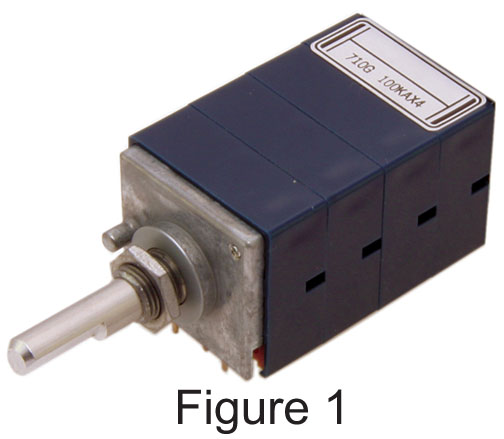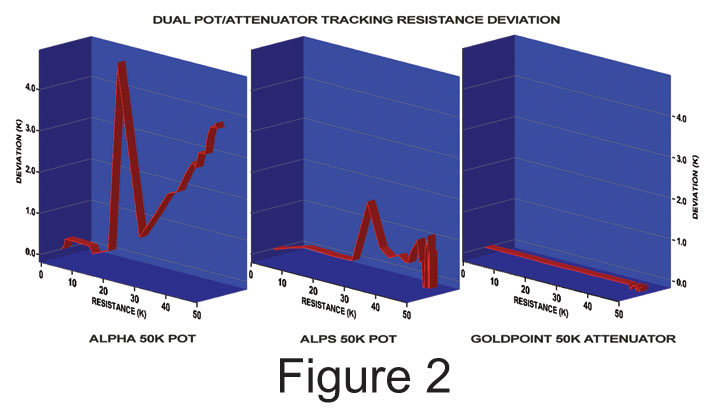What Price For Perfection?
By Bryan Bergeron
When you walk into a showroom that caters to audiophiles, it’s easy to be impressed by massive speakers, rare metal cables and connectors, and the solid, hefty feel of superbly designed audio gear. That said, how does one rationalize spending $10,000 for an amp or $6,000 for a preamp, when the cost per gram approaches that of 24K gold? There is, of course, a premium extracted by the vendor for high-end, name brand, hand-assembled electronics. However, with the exception of exotic power and speaker cables, it’s not all marketing.

If you pop the cover on an audiophile amp or preamp, odds are you won’t see typical components. Power supplies tend to be massive, over-designed affairs with huge banks of expensive electrolytic capacitors and specially wound toroidal transformers. The tubes and discrete active components may be hand matched. Even something as simple as a volume control suddenly takes on new meaning. Instead of a $2 Alpha or RadioShack potentiometer, you’ll likely find a $45 ALPS potentiometer (Figure 1) or even a $200 DACT or GoldPoint stepped attenuator.
From a project development perspective, are audiophile quality components worth it? After all, if you’re going to invest a weekend or more on a project, why not go for the best components possible, instead of finding the best deal in a discount parts bin? Is there a real difference? From a purely electrical perspective, it’s often an easy task to differentiate components. Take the significance of the tracking accuracy of staked potentiometers, for example.
 Figure 2 shows the tracking accuracy of stacked audio taper pots from Alpha and ALPS, and a stepped attenuator from GoldPoint. I measured resistances with a recently calibrated Fluke 45 DMM at room temperature. From the figure, you can see that there is virtually no difference between the resistance provided by each stack in the GoldPoint step attenuator from the range of 0-50K. That is, when the attenuator is at midpoint, both stacks — say, left and right volume control resistance — present exactly the same resistance, within the measurement capabilities of my DMM. The less expensive ALPS potentiometer has a maximum resistance difference of about 1.5K, with most of the difference noted above about 25K. The inexpensive Alpha potentiometer shows the greatest deviation in resistance between its stacked potentiometers, with a maximum of about 5K to around 21K.
Figure 2 shows the tracking accuracy of stacked audio taper pots from Alpha and ALPS, and a stepped attenuator from GoldPoint. I measured resistances with a recently calibrated Fluke 45 DMM at room temperature. From the figure, you can see that there is virtually no difference between the resistance provided by each stack in the GoldPoint step attenuator from the range of 0-50K. That is, when the attenuator is at midpoint, both stacks — say, left and right volume control resistance — present exactly the same resistance, within the measurement capabilities of my DMM. The less expensive ALPS potentiometer has a maximum resistance difference of about 1.5K, with most of the difference noted above about 25K. The inexpensive Alpha potentiometer shows the greatest deviation in resistance between its stacked potentiometers, with a maximum of about 5K to around 21K.
There are also practical differences between the expected longevity of audiophile and commodity components. For example, if you look through your Mouser or Jameco catalog, you’ll find that many components are categorized by accuracy of value, longevity at a certain temperature, or use. Garden-variety potentiometers are typically rated at 10,000 turns. That’s one turn per day for about 27 years. In comparison, the GoldPoint step attenuator with gold-plated contacts is warranted for three years, regardless of use level.
Mean time before failure (MTBF), size, weight, thermal stability, resistance to caustic elements in the environment, and similar hard measures aside, in evaluating components, there is the issue of psychophysics — the relationship between physical stimuli and perception. In the case of stacked potentiometers or stepped attenuators, one psychophysical issue is whether the relative difference in resistance is noticeable. Most of us can detect a 3 dB change in volume, and someone with an exceptionally good ear can detect differences of about 1 dB. However, without details of the circuit controlled by each of the pots/attenuator in Figure 2, it’s difficult to determine whether the differences in resistance would result in detectable differences in volume. Certainly, given the same stereo amplifier circuit, the GoldPoint step attenuator and ALPS potentiometer are less likely to cause a noticeable difference in output than is the Alpha potentiometer.
Another psychophysical factor to consider when evaluating audiophile-grade components is feel. A stepped attenuator bolted to a quarter-inch thick aluminum front panel and attached to a solid aluminum knob simply feels better to the touch than a $2 pot affixed to a flimsy front panel and attached to a plastic knob. Whether you’re willing to pay five or ten times more for audiophile-quality feel is a personal decision. Car enthusiasts don’t buy chrome-plated engine parts for increased performance.
If you take the time to familiarize yourself with audiophile designs and components, you’ll open new possibilities in your design and repair repertoire. You’ll also be better prepared to spot quality audio components and gear on eBay. And if you’ve designed audiophile circuits, please consider sharing your work with your fellow readers. NV
RESOURCES
Alpha Potentiometers — [url=http://www.alphapotentiometers.net]http://www.alphapotentiometers.net[/url]
ALPS Potentiometers — [url=http://www.alps.com]http://www.alps.com[/url]
GoldPoint Stepped Attenuators — [url=http://www.goldpt.com]http://www.goldpt.com[/url]
DACT Stepped Attenuators — [url=http://www.dact.com/html/attenuators.html]http://www.dact.com/html/attenuators.html[/url]
Comments


 Figure 2 shows the tracking accuracy of stacked audio taper pots from Alpha and ALPS, and a stepped attenuator from GoldPoint. I measured resistances with a recently calibrated Fluke 45 DMM at room temperature. From the figure, you can see that there is virtually no difference between the resistance provided by each stack in the GoldPoint step attenuator from the range of 0-50K. That is, when the attenuator is at midpoint, both stacks — say, left and right volume control resistance — present exactly the same resistance, within the measurement capabilities of my DMM. The less expensive ALPS potentiometer has a maximum resistance difference of about 1.5K, with most of the difference noted above about 25K. The inexpensive Alpha potentiometer shows the greatest deviation in resistance between its stacked potentiometers, with a maximum of about 5K to around 21K.
Figure 2 shows the tracking accuracy of stacked audio taper pots from Alpha and ALPS, and a stepped attenuator from GoldPoint. I measured resistances with a recently calibrated Fluke 45 DMM at room temperature. From the figure, you can see that there is virtually no difference between the resistance provided by each stack in the GoldPoint step attenuator from the range of 0-50K. That is, when the attenuator is at midpoint, both stacks — say, left and right volume control resistance — present exactly the same resistance, within the measurement capabilities of my DMM. The less expensive ALPS potentiometer has a maximum resistance difference of about 1.5K, with most of the difference noted above about 25K. The inexpensive Alpha potentiometer shows the greatest deviation in resistance between its stacked potentiometers, with a maximum of about 5K to around 21K.